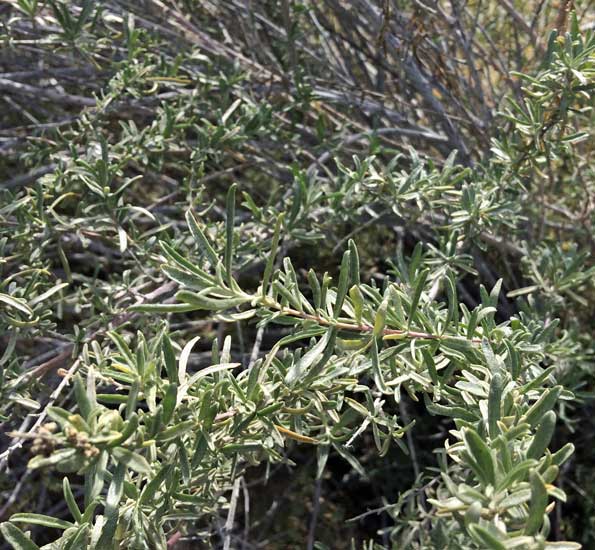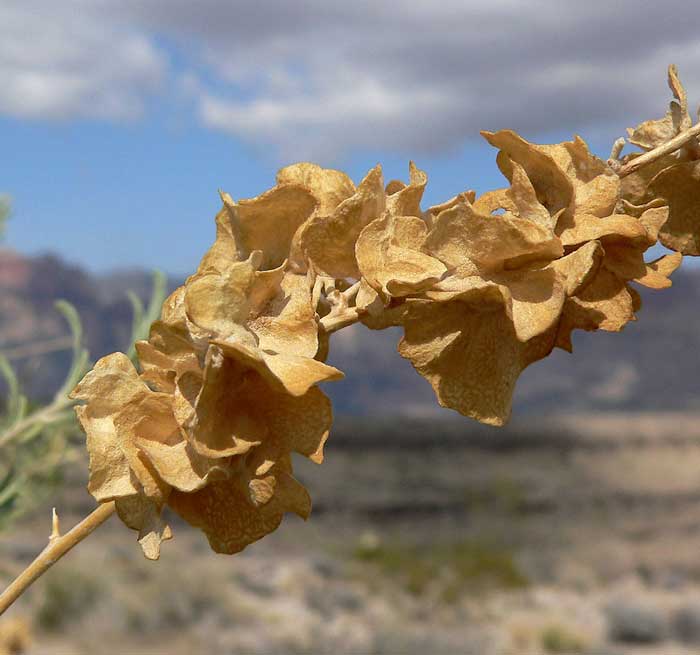Ethnobotany of southern California native plants:
Four-Wing Saltbush (Atriplex canescens)

Tough, drought resistant foliage on the four-wing saltbush.

by Stan Shebs GFDL, CC BY-SA 3.0
The four wings of the paper-textured saltbush seeds.
Four-Wing Saltbush (Atriplex canescens)
Four-wing saltbush is a medium-sized shrub that is native to California. Its also found in other states in the American southwest. The shrub is common in dry, sandy soils.
The defining feature of this plant is the fruit, which has four wings that sit at 90 degree angles. This shape allows the seeds to take flight in the wind and disperse the next generation. These paper-textured fruits emerge from the entire length of the plant’s stems.
Four-wing saltbush has a long flowering period, from April to October.
Uses for the Four-Wing Saltbush
Southwestern Native Americans collected the leaves and seeds of this plant. The seeds were often steeped in boiling water, then eaten as a mush. As such, the seeds provided a good source of niacin. The seeds were also grounded into a nutritious flour. This seed flour boasted a protein content of at least 10%. Occasionally, the seeds were ground up and made into a beverage with water and sugar. This drink was called pinole.
The leaves could be eaten raw.
The Zuni people were especially fond of this plant. They infused the dried root and flower petals then used the soapy concoction to clean their skin. The fact that this plant produces a lather, suggests the plant is rich in detergent saponins.
In order to secure a productive cottontail rabbit hunt, the Zuni would attach saltbush twigs to prayer plumes and offer up a sacrificial smoke smudge.
The Havasupai people also pounded the leaves into a soapy lather. They then used this mixture to wash their hair and treat skin irritations and measles.
Medicinal use of Fourwing Saltbush
The Paiute boiled the leaves and used the mixture as treatment for aches and sore muscles.
Zuni people relieved the pain and swelling from insect stings by applying a salve derived from the fourwing saltbush. They would chew the flowers and roots and mix the plant material with their saliva. This compound was then added directly to the affected skin.
References:
Colton, Harold S. 1974 Hopi History And Ethnobotany. IN D. A. Horr (ed.) Hopi Indians. Garland: New York. (p. 292)
Fewkes, J. Walter 1896 A Contribution to Ethnobotany. American Anthropologist 9:14-21 (p. 21)
Vestal, Paul A. 1952 The Ethnobotany of the Ramah Navaho. Papers of the Peabody Museum of American Archaeology and Ethnology 40(4):1-94 (p. 24)
Please return to our main Ethnobotany of southern California page.
On our main ethnobotany page, we present a clickable list of the southern California native plants that became a part of the culture of Native Americans and early European settlers. These plants were used for medicine, food, shelter, drink, tools and art.
Warning: The information about plants on this website is intended for general educational purposes only. The author of this website accepts no responsibility for problems arising from the user’s misidentification, misuse, or use of plants. Please read the full TERMS associated with this website.
